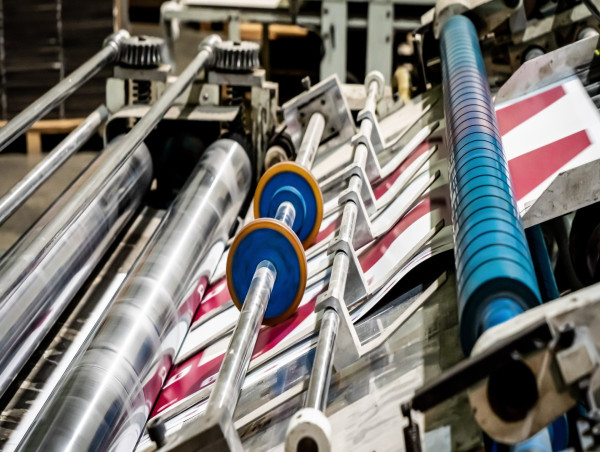The print industry isn't simply declining; it's evolving. Traditional sectors face reduced demand due to digital media's rise, but other areas are growing.
SALT LAKE CITY, UTAH, UNITED STATES, January 26, 2024 /EINPresswire.com/ -- The print industry, long considered the backbone of information and communication, is at a crossroads. With advancements in digital technology and shifts in consumer behavior, questions arise about its current state and future trajectory. In terms of employment and number of print shops, the industry is in decline. There are large declines in traditional print, offset by certain product categories like packaging and label printing.
The decline in traditional print sectors is undeniable. According to Smithers' report "The Future of Global Printing to 2024," the global print market is experiencing a shift. However, sales are still growing, albeit modestly - the market value is expected to rise from $818 billion in 2019 to $874 billion by 2024, this represents a modest compound annual growth rate of 1.3%. Commercial print sectors such as advertising and promotional materials are seeing reduced volumes, alongside a similar decline in most print publications like newspapers and magazines. This decline is attributed to the increasing preference for digital media consumption and the efficiency of digital platforms in delivering content.
The overall slight uptick in sales, combined with a decrease in firms and employees indicates consolidation in the industry, combined with changes in automation and technology.
The COVID-19 pandemic significantly impacted the print industry, leading to several challenges and changes in operations and market dynamics.
1. Decline in Demand and Revenue: The print industry experienced a notable decrease in demand and revenue during the pandemic. This was partly due to the decline in events like weddings, exhibitions, and business conferences, which typically require a lot of printed materials like flyers, banners, and business cards. Implementing lockdowns and social distancing measures led to canceling many such events, reducing the need for print marketing.
2. Impact on Different Sectors: While the overall industry faced a downturn, the effect varied across different print industry sectors. For instance, wide-format display and point-of-sale printers suffered significantly due to the reduced footfall in shops, restaurants, bars, and hotels. Commercial print sectors like business forms, newsletters, and manuals also saw a sharp decline in demand during the second and third quarters of 2020.
3. Packaging and Labels: On the other hand, packaging and labels were less affected by the pandemic than other segments. During panic buying and stockpiling, there was a temporary increase in demand for food, beverage, and pharmaceutical packaging. However, the usage of transit and industrial packaging, which carries limited printing, decreased.
4. Shift Towards Digital Media: The pandemic accelerated the transition from paper to digital processes, as many people started working from home and became accustomed to digital workflows. This shift led to decreased office print volumes and highlighted the need for the print industry to adapt by expanding digital, cloud, and collaboration services.
5. Adaptation and Recovery: Despite the challenges, the print media sector started returning, especially in the final quarter of the financial year 2023. This was attributed to the easing of lockdown measures and increased consumer demand and spending patterns, particularly in smaller cities.
6. E-commerce and Online Sales: The pandemic also increased e-commerce, increasing the demand for e-commerce packaging. This created opportunities for print service providers (PSPs) to offer value-added options in packaging, catering to the rising online shopping trend.
The recent advancements in automation and artificial intelligence within the printing industry have significantly influenced its growth and employment dynamics. While these technological innovations have increased productivity and efficiency, they have also reduced the need for a large workforce. This has been evident in the decline in employment within the industry. A notable example is highlighted in a Smithers report, which showed a 14.8% reduction in employees in printing businesses from 2018 to 2022.
This trend suggests that while automation may foster growth and efficiency in production processes, it also necessitates a shift in the workforce, with declining demand for traditional printing roles and an increased need for skills in managing and maintaining advanced technological systems.
Despite these challenges, the industry is not in terminal decline but is instead evolving. Areas such as printed packaging and labels are booming, driven by the unceasing need for physical packaging in an increasingly e-commerce-driven world. The sector also shows growth in regions like Latin America, Eastern Europe, and Asia, indicating a geographic shift in print demand.
Innovations in the industry are also paving the way for a more sustainable future. Print companies increasingly adopt eco-friendly methods, utilizing recycled materials and sustainable inks. This environmentally responsible approach aligns with the growing consumer demand for sustainable products.
Looking ahead, the future of the print industry is intertwined with digital integration and specialization. Adopting digital printing technologies enables more personalized and on-demand printing solutions. For instance, short-run and print-on-demand services are becoming more prevalent in the publishing sector, allowing for more efficient and cost-effective production.
Direct mail is making a solid comeback as part of omnichannel marketing strategies. It combines the tangibility of physical mail with the precision of digital targeting. Additionally, using AI and automation in printing will enhance productivity and innovation in design and content creation.
E-commerce businesses also have substantial success as print moves from local shops to e-commerce houses. CustomStickers.com is an example of a print company that has seen rapid growth. The company's success is attributed to its focus on production optimization and automation, which allows it to deliver high-quality custom stickers efficiently and cost-effectively.
This approach, coupled with advanced manufacturing capabilities like automated finishing equipment and high-resolution printing presses, has rapidly enabled CustomStickers to grow and cater to a wide range of customers. Their innovative business model and use of technology showcase how specific segments within the print industry, like stickers and labels, are flourishing despite the overall industry's challenges.
Gracie Haroldson
CK Brands, LLC
+1 385-223-8109
email us here
![]()






